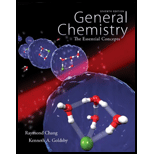
(a)
Interpretation:
Molar heat of vaporization of diethyl ether has to be estimated at
Concept Introduction:
Spontaneous process: A process which is initiated by itself, without the help of external energy source is called spontaneous process. All spontaneous process is associated with the decrease in free energy in the system.
Vapour pressure: Vapor pressure is defined as the pressure exerted by a vapor in
Vapour pressure is nothing but the tendency of particles to escape from the liquid (or) solid.
Enthalpy changes: The changes in enthalpy that accompanies the formation of one mole of the compound at its normal state from its constituent elements in their standard state.
According to Trouton's rule for, various liquids at their boiling point the change in entropy value will be the same. The ratio of enthalpy of vaporization and boiling temperature of various liquids has the same value.
Where,
(b)
Interpretation:
Vapour pressure of diethyl ether has to be estimated at
Concept Introduction:
Spontaneous process: A process which is initiated by itself, without the help of external energy source is called spontaneous process. All spontaneous process is associated with the decrease in free energy in the system.
Vapour pressure: Vapor pressure is defined as the pressure exerted by a vapor in thermodynamic equilibrium with its condensed phases (solid or liquid) at a given temperature in closed system.
Vapour pressure is nothing but the tendency of particles to escape from the liquid (or) solid.
Enthalpy changes: The changes in enthalpy that accompanies the formation of one mole of the compound at its normal state from its constituent elements in their standard state.
According to Trouton's rule for, various liquids at their boiling point the change in entropy value will be the same. The ratio of enthalpy of vaporization and boiling temperature of various liquids has the same value.
Where,
Want to see the full answer?
Check out a sample textbook solution
Chapter 18 Solutions
Connect 2-Year Access Card for Chemistry: The Essential Concepts
 ChemistryChemistryISBN:9781305957404Author:Steven S. Zumdahl, Susan A. Zumdahl, Donald J. DeCostePublisher:Cengage Learning
ChemistryChemistryISBN:9781305957404Author:Steven S. Zumdahl, Susan A. Zumdahl, Donald J. DeCostePublisher:Cengage Learning ChemistryChemistryISBN:9781259911156Author:Raymond Chang Dr., Jason Overby ProfessorPublisher:McGraw-Hill Education
ChemistryChemistryISBN:9781259911156Author:Raymond Chang Dr., Jason Overby ProfessorPublisher:McGraw-Hill Education Principles of Instrumental AnalysisChemistryISBN:9781305577213Author:Douglas A. Skoog, F. James Holler, Stanley R. CrouchPublisher:Cengage Learning
Principles of Instrumental AnalysisChemistryISBN:9781305577213Author:Douglas A. Skoog, F. James Holler, Stanley R. CrouchPublisher:Cengage Learning Organic ChemistryChemistryISBN:9780078021558Author:Janice Gorzynski Smith Dr.Publisher:McGraw-Hill Education
Organic ChemistryChemistryISBN:9780078021558Author:Janice Gorzynski Smith Dr.Publisher:McGraw-Hill Education Chemistry: Principles and ReactionsChemistryISBN:9781305079373Author:William L. Masterton, Cecile N. HurleyPublisher:Cengage Learning
Chemistry: Principles and ReactionsChemistryISBN:9781305079373Author:William L. Masterton, Cecile N. HurleyPublisher:Cengage Learning Elementary Principles of Chemical Processes, Bind...ChemistryISBN:9781118431221Author:Richard M. Felder, Ronald W. Rousseau, Lisa G. BullardPublisher:WILEY
Elementary Principles of Chemical Processes, Bind...ChemistryISBN:9781118431221Author:Richard M. Felder, Ronald W. Rousseau, Lisa G. BullardPublisher:WILEY





